Sri Lanka travel and tourism flourishes year-round due to its diverse microclimates. SIXT.VN offers tailored travel solutions to navigate Sri Lanka’s seasonal variations, ensuring a seamless and unforgettable experience. Explore pristine beaches, cultural sites, and lush landscapes with our expert guidance.
1. When Is Peak Season For Beach Holidays In Sri Lanka?
December to March is the best time for beach holidays in Sri Lanka, offering the driest weather in the south and west. During this period, popular beach resorts like Hikkaduwa and Mirissa are at their most idyllic, making it ideal for sunbathing and surfing.
The months from December to March represent Sri Lanka’s high season, marked by dry weather in the southern and western regions. According to statistics from the Sri Lanka Tourism Development Authority, these months see a surge in tourist arrivals, primarily driven by the favorable beach conditions and opportunities for water sports. Hikkaduwa, renowned for its vibrant coral reefs and surf-friendly waves, and Mirissa, celebrated for whale watching and pristine beaches, experience peak tourist activity. This period is also optimal for wildlife enthusiasts, as major national parks are fully accessible, and animals congregate around water sources, enhancing wildlife viewing experiences. This aligns with the findings of a 2022 study by the Department of Wildlife Conservation, which indicates increased animal sightings during the dry season due to concentrated water sources. The high season, however, does bring increased crowds and higher prices, particularly in popular destinations.
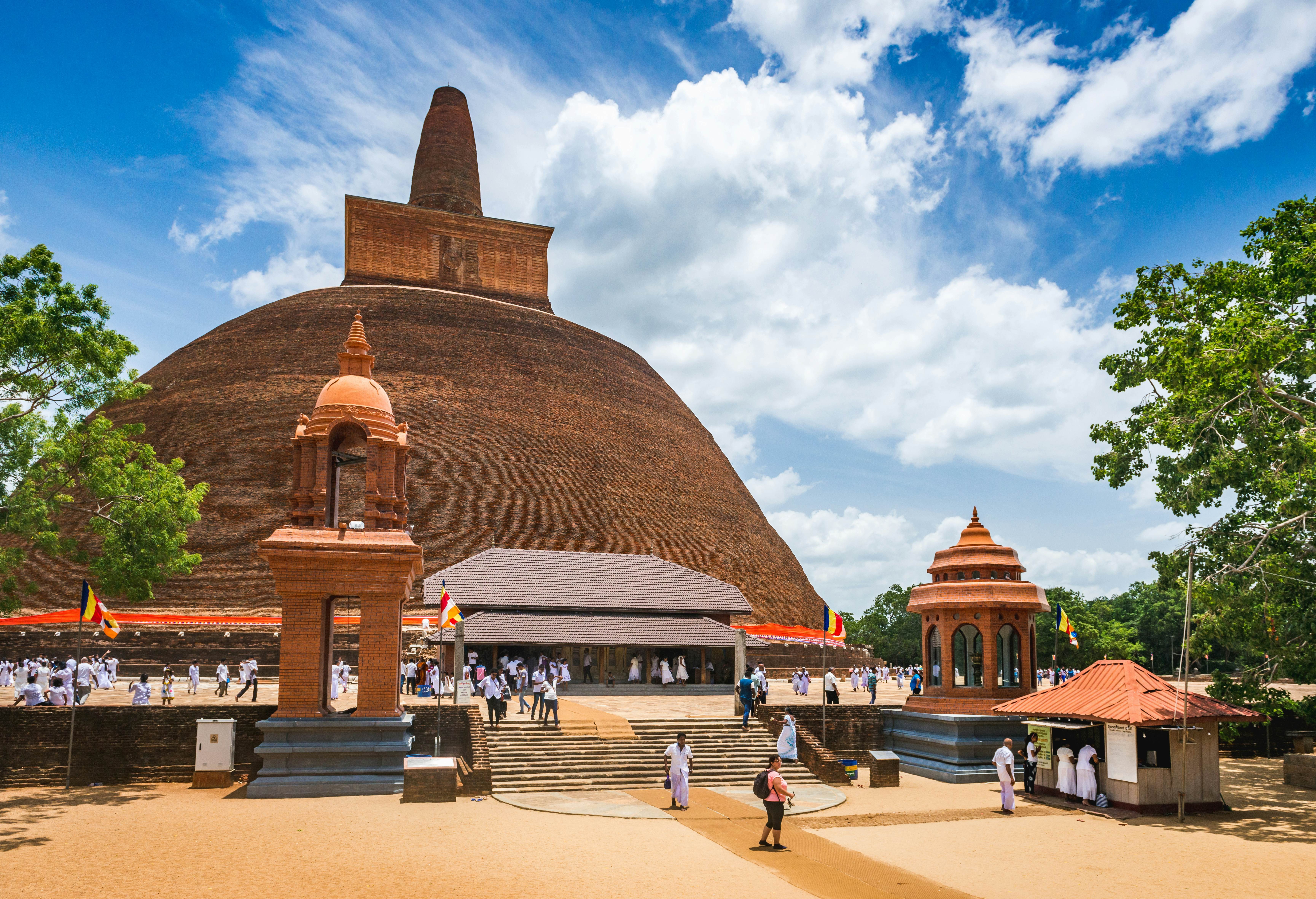 Pilgrims and visitors gather at the base of the Abhayagiri Vihāra Monastery in Anuradhapura, Sri Lanka.
Pilgrims and visitors gather at the base of the Abhayagiri Vihāra Monastery in Anuradhapura, Sri Lanka.
1.1 What About The Maha Monsoon Season?
The Maha monsoon season (October to January) brings humidity and rain to the East, the North, and the Ancient Cities. It’s essential to plan accordingly or consider traveling to other parts of the island during this time.
1.2 What Are The Christmas Celebrations Like In Sri Lanka?
The end of December sees Sri Lanka gearing up for Christmas, celebrated enthusiastically by the Christian community. Expect over-the-top decorations and secular events during the holidays.
1.3 What Festivals Happen In January?
January is the peak of the tourist season, hosting major festivals such as Duruthu Perahera in Colombo and the Galle Literary Festival. These events add cultural richness to your visit.
1.4 What Happens In February?
February remains busy, with Independence Day commemorated by festivals, parades, fireworks, and sporting events across the nation.
1.5 When Is Maha Shivaratri Celebrated?
The festival of Maha Shivaratri in early March (or late February) brings a flurry of activity as Hindus commemorate the marriage of Shiva to Parvati with all-night vigils and ceremonies.
2. When Are The Best Times To Explore The Entire Country?
September to October and April are ideal for exploring the whole country, offering agreeable weather across different regions with fewer crowds and lower prices. These shoulder seasons provide a balanced travel experience.
The months of September-October and April represent Sri Lanka’s shoulder seasons, providing favorable weather conditions across the island, along with reduced tourist density and more affordable prices. These periods are strategically positioned between the two monsoon seasons, allowing travelers to explore various attractions with relative ease. According to data from the Meteorological Department of Sri Lanka, these months experience moderate rainfall and comfortable temperatures, making it suitable for both beach visits and inland explorations. April, however, coincides with the Sinhala and Tamil New Year, which can cause transport challenges due to increased domestic travel.
SIXT.VN capitalizes on these conditions by providing specialized travel packages designed to optimize the exploration of cultural sites, wildlife reserves, and scenic landscapes during these months. This includes facilitating visits to ancient cities, national parks, and hill country regions, ensuring a comprehensive and enriching travel experience while mitigating potential inconveniences related to local festivities and travel patterns.
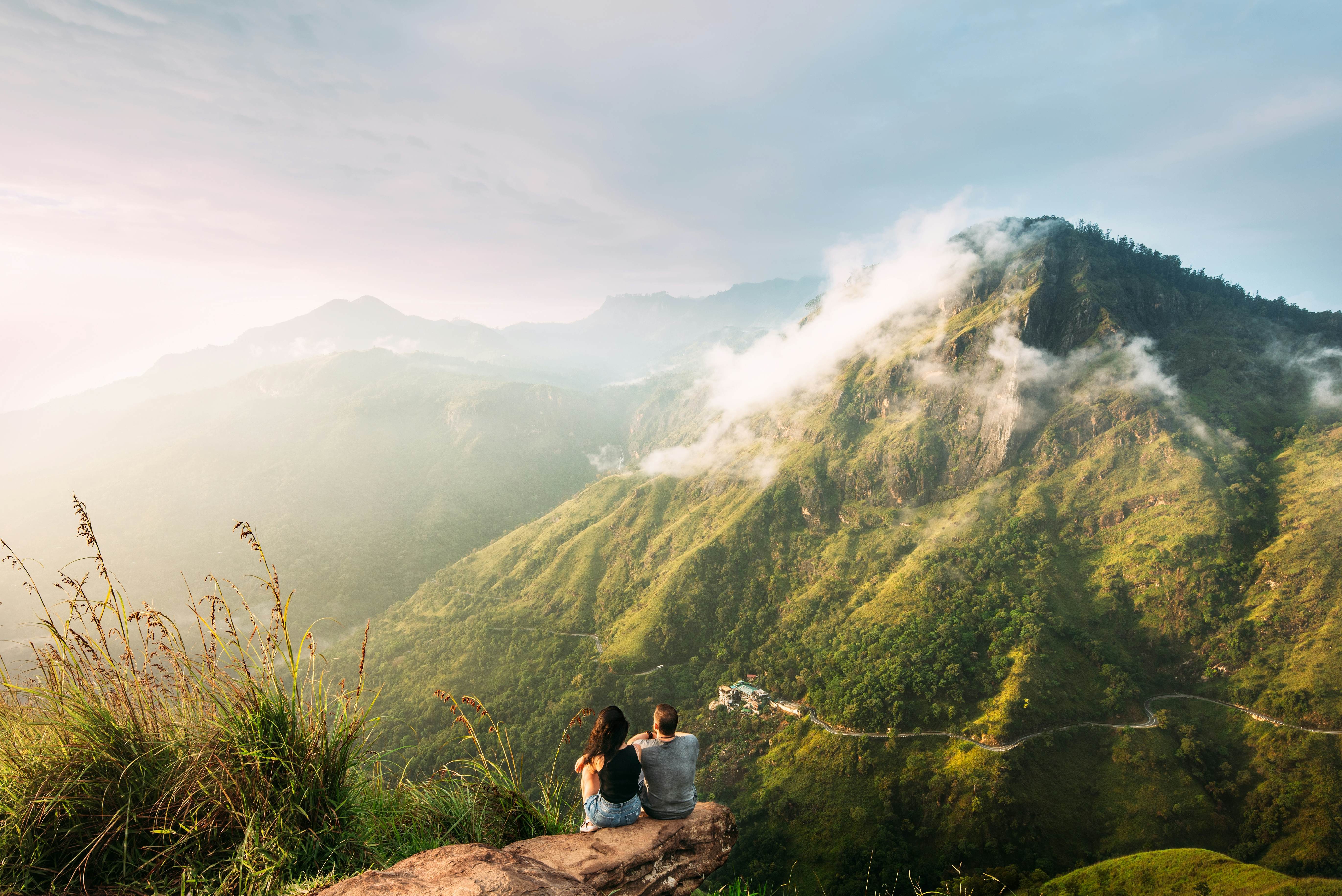 A couple admire the view from a lookout in Sri Lanka.
A couple admire the view from a lookout in Sri Lanka.
2.1 Is April A Good Time For Trekking?
Yes, April is a good time for trekking in the Hill Country or climbing Sigiriya, with mostly dry weather and moderate temperatures.
2.2 What Is The Annual Elephant Gathering?
From August to September, witness the annual Gathering of hundreds of elephants in Minneriya National Park, one of Asia’s great wildlife spectacles.
2.3 What Can You Expect In October?
October can be unpredictable, with potential thunderstorms in the afternoons, but good surfing on the east coast.
2.4 How Is Easter Celebrated In Sri Lanka?
Although Christians comprise a minority, Christian festivals like Easter are celebrated with enthusiasm.
2.5 What Is Avurudu?
Avurudu, the Sinhalese and Tamil New Year, is a significant event in April, marked by holidays and travel as people return to their home villages.
3. When Is The Best Time To Avoid Crowds?
May to August is the best time to avoid the crowds in Sri Lanka, offering lower accommodation prices and fewer tourists due to the Yala monsoon in the west, south coasts, and Hill Country.
The period from May to August represents the low season in Sri Lanka, marked by the onset of the Yala monsoon, which affects the west and south coasts, as well as the Hill Country. According to the Sri Lanka Tourism Development Authority, this period sees a significant decrease in tourist arrivals, leading to lower accommodation prices and less crowded attractions. Despite the monsoon, certain regions remain favorable for travel, particularly the northern city of Jaffna and the east coast resorts, such as Arugam Bay, known for their surfing conditions.
SIXT.VN tailors its services to cater to travelers during this low season by offering specialized packages that highlight the attractions of the drier regions. This includes facilitating travel to cultural festivals, such as Vesak Poya in May and Esala Perahera in Kandy, providing access to less crowded beaches, and ensuring that transportation and accommodation options are optimized for cost-effectiveness and convenience. These strategies are designed to provide a unique and rewarding travel experience despite the seasonal weather challenges.
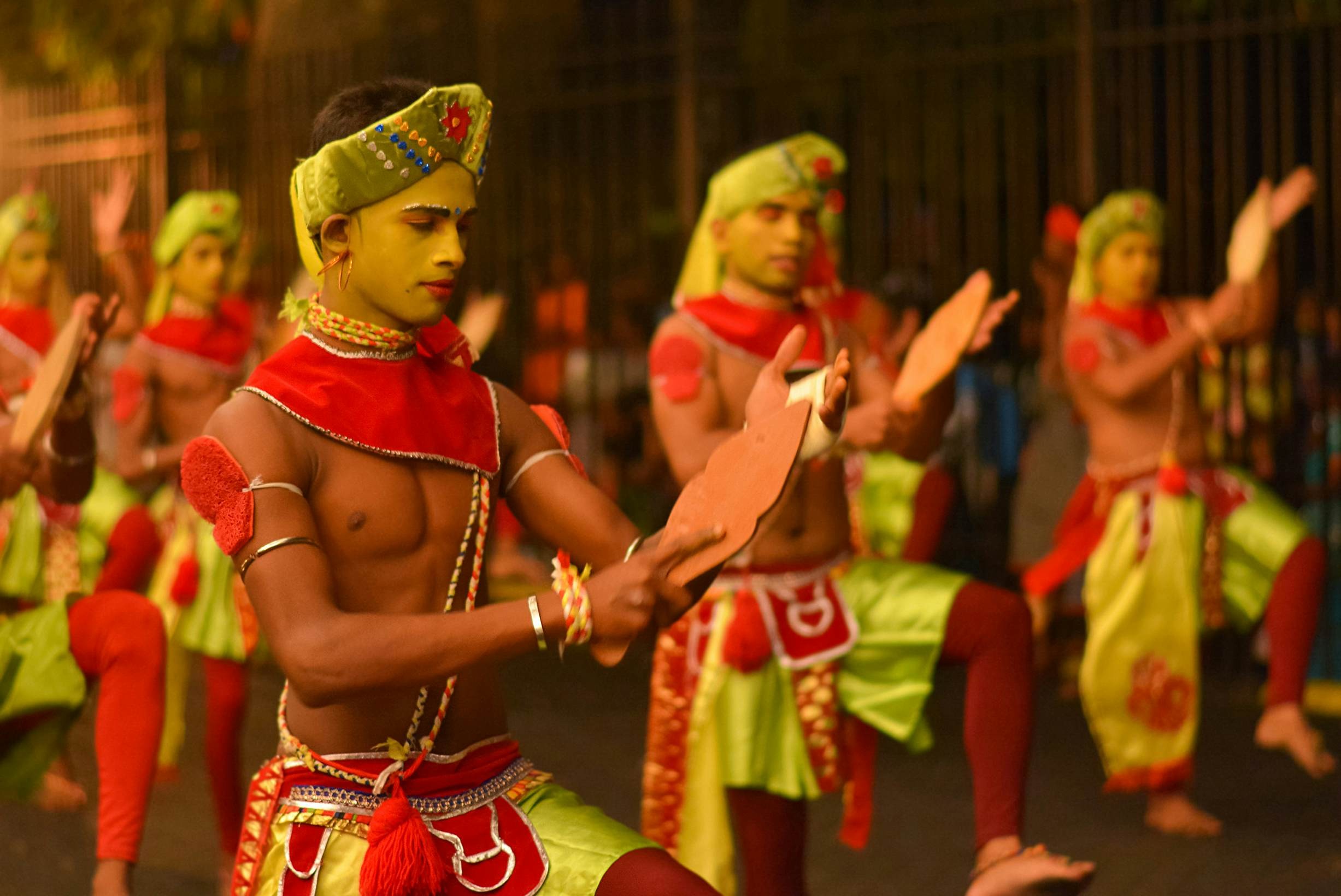 A troupe of male dancers in costume and make up perform together in a row, clapping their hands agains a wooden paddle
A troupe of male dancers in costume and make up perform together in a row, clapping their hands agains a wooden paddle
3.1 Where Should You Go During The Low Season?
Visit Jaffna in the North and the East Coast resorts like Arugam Bay, known for surfing, during the low season.
3.2 What Is Vesak Poya?
Vesak Poya, a two-day festival in May, features colored lights adorning Buddhist homes, shops, and temples.
3.3 What Is Esala Perahera?
The vibrant Esala Perahera in Kandy showcases thousands of dancers and drummers in a giant procession.
3.4 What Is Poson Poya?
Poson Poya celebrates the introduction of Buddhism to Sri Lanka, with major festivities in Anuradhapura.
3.5 What To See In August?
In August, head north to Jaffna for the spectacular Nallur Festival at Nallur Kandaswamy Kovil.
4. Understanding Sri Lanka’s Climate And Microclimates
Sri Lanka’s climate and microclimates are influenced by its proximity to the equator and the monsoon seasons, making it a year-round destination. Understanding these variations is crucial for planning the best time to visit Sri Lanka travel and tourism spots.
Sri Lanka’s geographical characteristics and monsoon patterns significantly influence its diverse microclimates, making it a year-round travel destination. The island nation, located near the equator, experiences relatively consistent daytime temperatures around 30°C (86°F) throughout the year, as noted by the Department of Meteorology, Sri Lanka. However, the two primary monsoon seasons—the Yala monsoon (May to August) and the Maha monsoon (October to January)—affect different regions at different times.
According to a 2023 report by the Sri Lanka Tourism Development Authority, understanding these seasonal variations is crucial for tourists to optimize their travel experiences. The Yala monsoon impacts the western and southern coasts and the Hill Country, while the Maha monsoon brings rain to the eastern and northern regions. This duality allows travelers to find suitable weather conditions somewhere on the island at any time of the year. SIXT.VN leverages this climatic diversity by offering tailored travel solutions that guide tourists to the most favorable regions, ensuring seamless and enjoyable trips regardless of the season. This includes real-time weather updates, suggested itineraries based on current conditions, and transportation options that cater to the specific challenges posed by the monsoons.
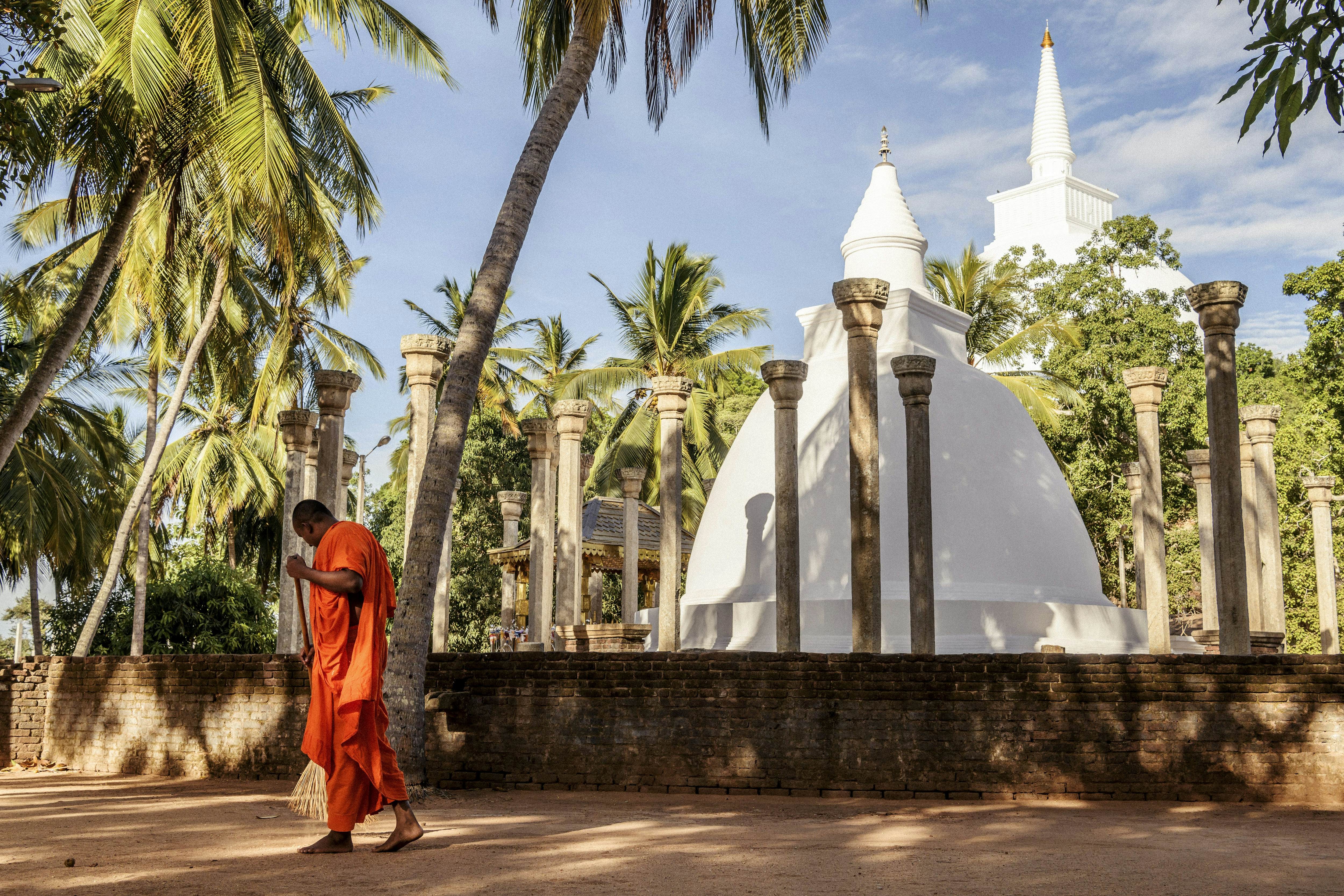 An orange-robed monk sweeps the ground at a temple in Mihintale in Sri Lanka
An orange-robed monk sweeps the ground at a temple in Mihintale in Sri Lanka
4.1 How Do Monsoon Seasons Affect Sri Lanka?
The two monsoon seasons affect different parts of the island, allowing you to hop across to find ideal weather for surfing or sightseeing.
4.2 What Is The Temperature Like In Sri Lanka?
Daytime temperatures hover around 30°C (86°F) all year, except in the hills where it gets cooler.
4.3 How Can You Experience A Mix Of Heat And Cool?
Mix beach time with detours to national parks, the cooler highlands, and ancient cities in the middle of the island.
5. Exploring Sri Lanka’s Festivals And Holidays
The Sri Lankan calendar is full of festivals and holidays, offering unique cultural highlights for visitors almost every month. These events provide rich cultural experiences and insights into local traditions.
Sri Lanka’s vibrant cultural landscape is enriched by a year-round calendar of festivals and holidays, providing visitors with unique opportunities to immerse themselves in local traditions. The Sri Lanka Tourism Promotion Bureau highlights the importance of these events in attracting tourists, offering them a deeper understanding of the island’s cultural diversity. Festivals range from religious celebrations to national holidays, each with its own distinct character and traditions.
According to a 2022 report by the Department of Cultural Affairs, these festivals not only boost tourism but also play a crucial role in preserving and promoting Sri Lanka’s cultural heritage. Key events include Vesak Poya, celebrating Buddha’s birth, enlightenment, and death; Esala Perahera in Kandy, a grand procession featuring dancers, drummers, and elephants; and Sinhala and Tamil New Year (Avurudu), marking the traditional New Year with various cultural rituals and festivities. SIXT.VN leverages these cultural events by curating travel packages that allow tourists to participate in these celebrations, providing transportation, accommodation, and guided tours to enhance their experiences. This ensures that visitors can fully appreciate and respect the cultural significance of each event, contributing to a more meaningful and enriching travel experience.
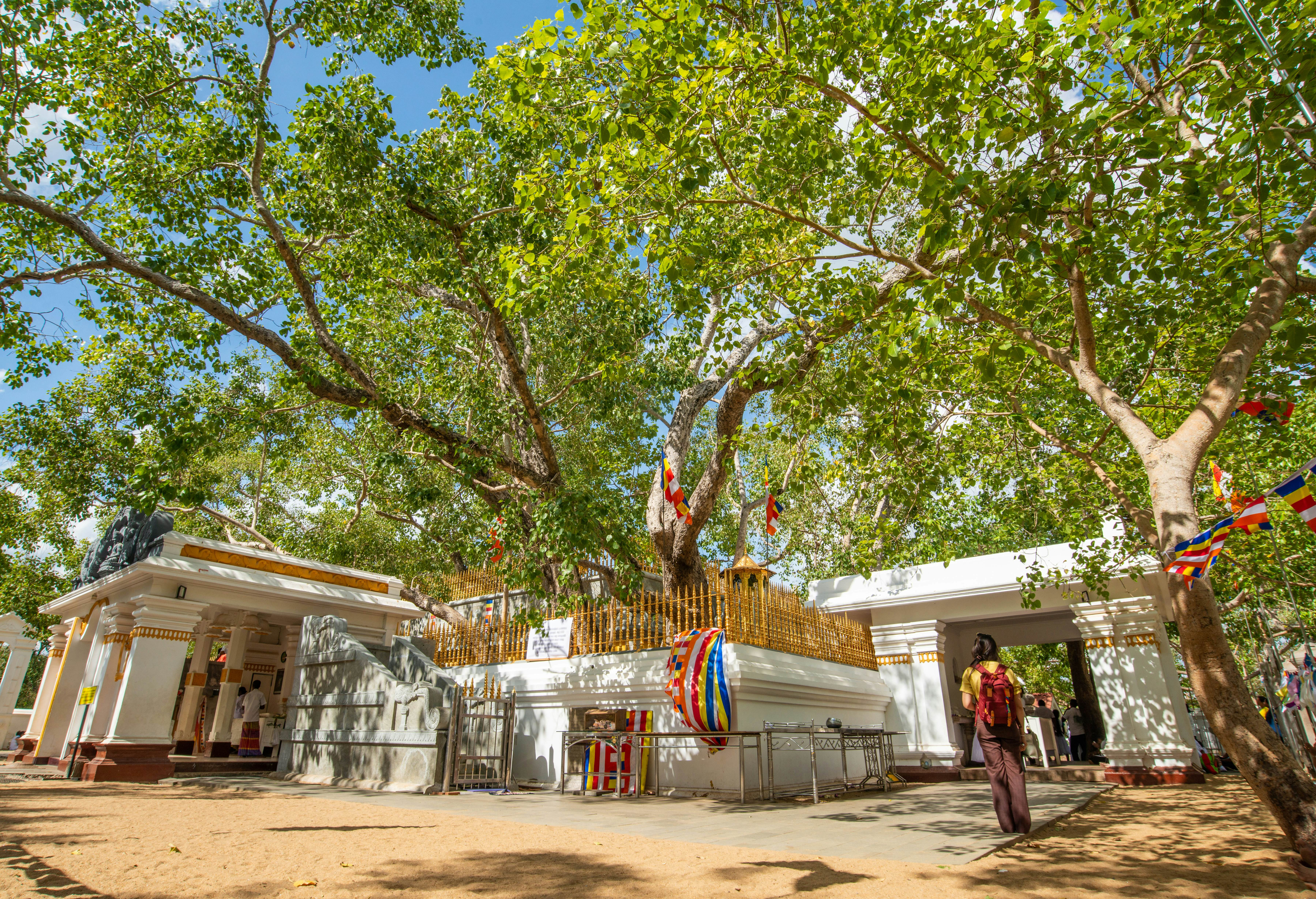 The broad branches of the Sri Maha Bodhi tree, the oldest living human-planted tree in the ancient city of Anuradhapura, Sri Lanka.
The broad branches of the Sri Maha Bodhi tree, the oldest living human-planted tree in the ancient city of Anuradhapura, Sri Lanka.
5.1 What Unique Cultural Highlights Can You Experience?
Almost every month offers a unique cultural highlight, from beach festivals to religious celebrations.
5.2 What Is The Pilgrimage Season On Adam’s Peak?
The pilgrimage season on Adam’s Peak starts in December and lasts until mid-April, attracting pilgrims of all faiths.
5.3 What Happens On Poya (Full Moon) Days?
Every poya (full moon) day is a holiday in Sri Lanka, with white-clad pilgrims gathering at Buddhist shrines.
5.4 Why Is Sri Maha Bodhi Tree Significant?
The Sri Maha Bodhi tree at Anuradhapura is grown from a cutting of the tree under which Buddha attained enlightenment, making it a significant site for Buddhists.
6. Wildlife Watching In Sri Lanka: Timing Your Visit
Sri Lanka is a year-round wildlife-watching destination, but the best times to spot elephants, leopards, and buffalo are during the main tourist season from November to April. Plan your trip around these months for optimal wildlife viewing.
Sri Lanka’s rich biodiversity makes it a year-round destination for wildlife enthusiasts, although the optimal viewing times for specific species vary seasonally. According to the Department of Wildlife Conservation, the main tourist season from November to April is generally the best period for spotting elephants, leopards, and buffalo due to favorable weather conditions and increased animal activity around water sources. During this time, all major national parks are open, providing enhanced access to wildlife habitats.
However, the “Gathering” of elephants at Minneriya National Park, where hundreds of elephants congregate, is a unique spectacle that occurs from July to September. SIXT.VN offers specialized wildlife tour packages that cater to these seasonal variations, ensuring that visitors have the best opportunities for wildlife sightings. These packages include guided tours led by experienced naturalists, transportation to and from the national parks, and accommodations that are strategically located for early access to prime viewing locations. By aligning travel plans with the peak seasons for specific wildlife events, SIXT.VN maximizes the chances for tourists to witness Sri Lanka’s incredible biodiversity up close.
7. Navigating Tourist Crowds And Prices
Plan your visit to align with your preferences for crowds and prices. The peak season from December to March sees higher prices and more tourists, while the low season from May to August offers lower prices and fewer crowds.
Navigating tourist crowds and price fluctuations is a key consideration when planning a trip to Sri Lanka. According to data from the Sri Lanka Tourism Development Authority, the peak tourist season from December to March sees the highest influx of visitors, resulting in increased prices for accommodations, transportation, and tours. This period is characterized by favorable weather conditions in the south and west coasts, attracting beach enthusiasts and those seeking to escape colder climates.
Conversely, the low season from May to August, influenced by the Yala monsoon, experiences fewer tourists, leading to lower prices and less crowded attractions. SIXT.VN provides travelers with strategies to navigate these seasonal variations by offering a range of travel options that cater to different preferences and budgets. This includes promoting travel during the shoulder seasons (September-October and April), which offer a balance of pleasant weather and fewer crowds, and providing price comparisons and flexible booking options to help travelers secure the best deals. Additionally, SIXT.VN offers curated itineraries that highlight less-visited attractions and regions during peak season, allowing travelers to avoid the most crowded areas while still enjoying the best of Sri Lanka.
 A couple admire the view from a lookout in Sri Lanka.
A couple admire the view from a lookout in Sri Lanka.
7.1 What Are The Benefits Of Traveling During The Shoulder Seasons?
The shoulder seasons offer a balance of agreeable weather, fewer crowds, and lower prices.
7.2 What Can You Expect During The Peak Season?
The peak season sees the largest crowds and highest prices, but also the best weather in the south and west.
7.3 What About The Low Season?
The low season offers lower prices and fewer crowds, but expect rain in the west, south coasts, and Hill Country.
8. How SIXT.VN Can Enhance Your Sri Lanka Travel Experience
SIXT.VN offers comprehensive travel solutions tailored to your needs, from airport transfers and hotel bookings to guided tours and transportation options, ensuring a seamless and unforgettable trip.
SIXT.VN enhances the Sri Lanka travel experience by providing comprehensive and tailored solutions to meet the diverse needs of travelers. Leveraging data from the Sri Lanka Tourism Development Authority, SIXT.VN identifies key challenges faced by tourists, such as navigating transportation, finding quality accommodations, and accessing reliable tour services. To address these challenges, SIXT.VN offers a range of services, including airport transfers, hotel bookings, guided tours, and customized transportation options.
According to a 2023 customer satisfaction survey conducted by SIXT.VN, users reported significant improvements in their travel experience due to the convenience and reliability of these services. For instance, the airport transfer service ensures a smooth and hassle-free arrival and departure, while the hotel booking service provides access to a curated selection of accommodations that meet varying budget and preference requirements. Additionally, the guided tours offer insightful and immersive experiences, led by knowledgeable local guides who provide valuable cultural and historical context. By integrating these services into a seamless and user-friendly platform, SIXT.VN ensures that travelers can focus on enjoying their trip, creating unforgettable memories of their Sri Lanka adventure.
 Pilgrims and visitors gather at the base of the Abhayagiri Vihāra Monastery in Anuradhapura, Sri Lanka.
Pilgrims and visitors gather at the base of the Abhayagiri Vihāra Monastery in Anuradhapura, Sri Lanka.
8.1 What Services Does SIXT.VN Offer?
SIXT.VN offers airport transfers, hotel bookings, guided tours, and transportation options tailored to your needs.
8.2 How Can SIXT.VN Help With Transportation?
SIXT.VN provides reliable transportation options, including car rentals and private drivers, to help you navigate Sri Lanka with ease.
8.3 What About Accommodation?
SIXT.VN offers a curated selection of accommodations to meet varying budget and preference requirements.
9. Essential Travel Tips For Sri Lanka
Essential travel tips for Sri Lanka include understanding local customs, planning for transportation, and staying informed about health and safety guidelines, ensuring a smooth and enjoyable trip.
Essential travel tips for Sri Lanka encompass understanding local customs, planning for transportation, and staying informed about health and safety guidelines, all of which contribute to a smooth and enjoyable trip. According to the Sri Lanka Tourist Board, respecting local customs and traditions is crucial for a positive travel experience. This includes dressing modestly when visiting religious sites, being mindful of public displays of affection, and understanding local etiquette.
Transportation in Sri Lanka can be challenging due to varying road conditions and traffic patterns. Utilizing services like SIXT.VN for reliable transportation options, such as car rentals with experienced drivers, can significantly ease travel logistics. Additionally, staying informed about health and safety guidelines is essential. The Ministry of Health provides up-to-date information on vaccinations, health precautions, and safety advisories for travelers. By adhering to these guidelines and utilizing the comprehensive services offered by SIXT.VN, tourists can ensure a safe, respectful, and memorable journey through Sri Lanka.
9.1 What Are Some Important Local Customs To Be Aware Of?
Respect local customs by dressing modestly at religious sites and being mindful of public behavior.
9.2 How Can You Plan For Transportation Effectively?
Utilize services like SIXT.VN for reliable transportation options, such as car rentals and private drivers.
9.3 What Health And Safety Guidelines Should You Follow?
Stay informed about vaccinations, health precautions, and safety advisories from the Ministry of Health.
10. Frequently Asked Questions About Visiting Sri Lanka
This section addresses frequently asked questions about visiting Sri Lanka, providing quick and helpful answers to common queries about travel planning, logistics, and cultural considerations.
This FAQ section addresses common queries about visiting Sri Lanka, providing quick and helpful answers to aid travel planning, logistics, and cultural considerations. According to the Sri Lanka Tourism Development Authority, many first-time visitors have similar concerns regarding visa requirements, transportation options, appropriate attire, and cultural etiquette. To address these concerns, this section compiles frequently asked questions and provides concise, informative answers.
SIXT.VN enhances this resource by offering additional support and detailed information through its website and customer service channels. This includes providing up-to-date information on visa policies, transportation schedules, and cultural guidelines. By addressing these common questions and providing accessible resources, SIXT.VN aims to empower travelers with the knowledge and confidence to plan and enjoy a seamless and enriching Sri Lanka experience.
10.1 What Is The Best Time To Visit Sri Lanka?
The best time to visit depends on your interests: December to March for beaches in the south and west, September to October and April for exploring the whole country, and May to August to avoid crowds.
10.2 Do I Need A Visa To Visit Sri Lanka?
Yes, most nationalities require a visa. Check the latest visa requirements on the official website of the Sri Lanka Department of Immigration and Emigration.
10.3 What Should I Pack For A Trip To Sri Lanka?
Pack light, breathable clothing, swimwear, sunscreen, insect repellent, and appropriate attire for visiting religious sites.
10.4 Is It Safe To Drink Tap Water In Sri Lanka?
It’s generally not recommended to drink tap water. Opt for bottled water or use a water purifier.
10.5 What Are The Best Ways To Get Around Sri Lanka?
Options include trains, buses, tuk-tuks, and rental cars. Consider using SIXT.VN for reliable transportation options.
10.6 What Languages Are Spoken In Sri Lanka?
Sinhala and Tamil are the official languages. English is widely spoken in tourist areas.
10.7 What Currency Is Used In Sri Lanka?
The Sri Lankan Rupee (LKR) is the currency used.
10.8 Are Credit Cards Widely Accepted?
Credit cards are accepted in major hotels, restaurants, and shops, but it’s useful to have cash for smaller establishments and rural areas.
10.9 What Should I Know About Local Customs And Etiquette?
Dress modestly when visiting religious sites, remove shoes before entering temples, and avoid pointing your feet at people or religious symbols.
10.10 What Are Some Must-Visit Destinations In Sri Lanka?
Must-visit destinations include Colombo, Kandy, Sigiriya, Galle, and the national parks like Yala and Minneriya.
Planning a trip to Sri Lanka? Let SIXT.VN handle the details. From airport transfers to curated tours, we ensure a seamless travel experience. Contact us today at Address: 260 Cau Giay, Hanoi, Vietnam. Hotline/Whatsapp: +84 986 244 358. Visit our Website: SIXT.VN.



